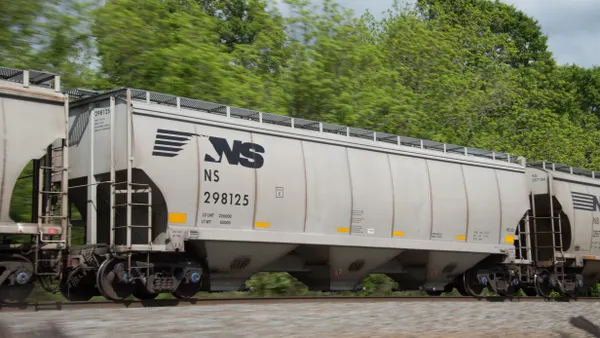Dive Brief:
- Norfolk Southern executives downplayed the growing chorus of tempered forecasts for rail growth in the balance of 2019 on the railroad's second-quarter earnings call Wednesday. "We remain confident [in] continued growth in the economy, although at a lower rate than what we experienced in 2018," said chief marketing officer (CMO) Alan Shaw.
- Shaw said he expects intermodal volume, which has shown signs of weakness in the first half of the year, will exceed the record levels seen in 2018 with a normal seasonal pickup in August, based on cues from the railroad's channel partners and bolstered by continued growth in consumer spending. "We've got the most powerful intermodal franchise in the east, which is married to the consumption part of the U.S. economy ... and the consumer related economic indicators are still relatively strong," Shaw said, emphasizing that international intermodal traffic is also included in its forecast.
- With or without continued volume growth, the railroad posted profitability gains despite a dip in overall volume — a trend several other railroads have demonstrated in second-quarter results. The railroad posted a 1% year-over-year gain in revenue for the quarter alongside a 4% dip in total volume.
Dive Insight:
The railroad is taking a much more optimistic view of the near-term than other Class I railroads. Norfolk Southern executives said even without volume growth, efficiency derived from the first phase of the railroad's transition to the principles of precisions-scheduled railroading (PSR), along with price increases and cutting costs wherever possible, will insulate it from any disappointments in future volume. The railroad reported an operating ratio of 63.6% for the quarter — down from 66% in Q1 and 64.6% in Q2 2018.
Beyond the lane rationalizations that came in the early stage of PSR implementation, Norfolk Southern's headcount is down 1,500 year-over-year. Almost immediately after beginning its PSR transition, the railroad adjusted pricing to reflect "the value of our improving service product," as described by Shaw. In the second quarter, the railroad gained 5% in revenue per unit from these increases.
On this front, and on past and future operational changes, Shaw said customers are on board.
"Customers see the improvement in our service product. They know that we're collaborating with them on our changes to our operating plan, they’re part of the discussion and they’re part of the process and they also know that we're providing them with a platform for growth," he said.
Analysts on the call expressed concern that price increases may not be tenable in a softer trucking market, but Shaw dismissed the concern. "There is some cyclicality in the truck market and you can find some lanes out there where the spot rate is under intermodal. However, we're not going to chase that," he said.
Phase two of Norfolk Southern's PSR implementation plan will begin next year when the railroad will focus on its intermodal network. CEO Jim Squires affirmed the railroad expects to continue to drive volume as it makes further network changes.














